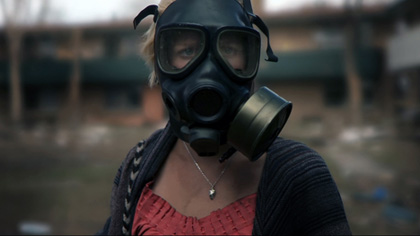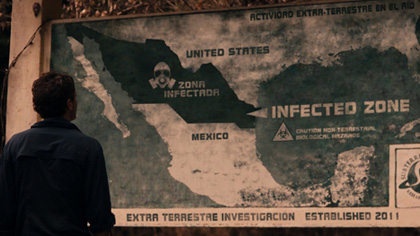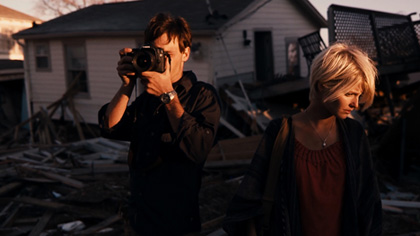Primary navigation


Blending road-movie and sci-fi, the fantastic and the everyday, Monsters is an astonishingly assured feature debut for its young British writer, director and special-effects designer Gareth Edwards, says Nick Roddick
Monsters does for the CGI generation what George A. Romero’s Night of the Living Dead did for 1960s horror: takes a series of increasingly tired conventions and reinvents them. And it does so in much the same way that Romero did: by creating a world that is, at base, completely realistic, then matter-of-factly introducing an element that changes everything – there, the zombies; here, aliens.
An astonishing achievement for first-time British feature director Gareth Edwards, most of whose previous experience has been in special effects, Monsters was shot for under £500,000 with a limited crew and two largely unknown actors. It’s a sci-fi thriller based on the premise that most of Mexico has become an Infected Zone populated by alien creatures. Two young Americans – photographer Andrew Kaulder (Scoot McNairy) and rich traveller Sam Wynden (Whitney Able) – get stranded south of the Zone at the start of “the season” (the aliens’ most active period) and are forced to cross it to return to the US. Monsters is as much a love story as it is a sci-fi thriller – and as much a road movie as it is either of those.
One of the film’s greatest pleasures is the casual way in which Edwards (credited as production designer as well as writer, director, cinematographer and effects designer) integrates the fantastic into the everyday: the road signs that casually mark off the kilometres to the Infected Zone; the children’s cartoon featuring a comic alien glimpsed on TV during the first overnight stop; the casual references to “the season”, as though it should be obvious to everyone what this means.
The crew evidently followed the same path as the protagonists, feeding off and building on what they found, occasionally dressing the real with elements of the unreal, as when they pass a cart hauling away the engine of a crashed US jet for scrap, or sail past some eerily abandoned hotel complexes on their way through the Zone. And the one lavishly developed physical effect – the pulsating, flashing alien spores attached to trees – is both appropriately creepy and a convincing imagination of what an alien life-form might look like.
The film certainly doesn’t look low-budget, and one suspects that, even if he’d had the resources of a Zack Snyder or a Michael Bay, Edwards would still have operated on a less-is-more principle. His film is more in the vein of Robert Wise’s 1963 The Haunting than Cloverfield – which could be a problem commercially. Edwards makes few concessions to the core horror audience. The visceral, night-vision opening apart, there are no sudden shocks – the initial alien attacks come not in heart-jolting cuts but via glimpses. Indeed, the only other shock the film delivers is not scary at all, but occurs in a soundtrack cut from a quiet riverside scene to the roar of the riverboat’s engine. Despite its obvious potential, this is no film for gore hounds: the eviscerated body of the lead guerrilla is not shown, merely glimpsed at the edge of the frame, causing Andrew to throw up.

Monsters is a film that’s very aware that other films precede it. The first sound is of a marine humming Wagner’s ‘Ride of the Valkyries’, Apocalypse Now-style, as they barrel along the Pan-American Highway, and Andrew and Sam’s river journey clearly references the same movie. But Monsters is equally determined to do things its own way. This is especially true of Edwards’s attitude to genre. The film certainly uses basic horror-film tropes – Andrew and Sam are thrown together in a situation of peril not once but twice, the second time inescapably. There are also a couple of those ‘don’t go in there’ moments without which horror movies could not operate. But Andrew and Sam are far from the stereotype model of boy protector / girl in peril. Sam’s role as the only Spanish-speaker gives her equal footing on the journey. And the traditional insensitivity of the disaster-zone photographer, set up in some of Andrew’s early scenes, is very much undercut when he finally comes across the money shot he has been seeking all along: a child killed by an alien. He removes the coat that has served as wrapping for his camera in his backpack, but instead of taking a picture, he gently covers the child’s body.
Andrew and Sam may start out as stereotypes – battle-weary pap, spoilt little rich girl – but they quickly develop into fully rounded characters who engage our attention as much as the eponymous creatures. Indeed the film is more or less a two-hander (the amiable sleazeball selling ferry tickets is the only other person to come close to character status) and the chemistry between McNairy and Able, a couple in real life, is one of the things that drives the film.
Where Edwards does veer back into Romero territory, however, is in the film’s final act, which begins as a lyrical journey through some breathtaking Mexican jungle scenery, includes a Mayan pyramid and the film’s most impressive CGI creation – the wall around the United States – before ending in a deserted, desolate Texas, an Armageddon-style landscape as scary and hopeless as anything in The Road. The area’s one living inhabitant, a mad homeless woman pushing a trolley of possessions, gets fourth billing in the credits and delivers the film’s most disturbing sound, a barking yelp of aggression and despair.
But this final sequence also elevates Monsters from a highly competent creature feature to something more intriguing. An isolated gas station is beautifully shot by Edwards, its lights glowing against a flat and empty landscape. It’s also the setting for the film’s all-important coda, in which fear gives way to awe as Andrew and Sam watch an encounter between two of the creatures bonding in a world that, to them, is far more alien than the Zone the humans have just been through. Just before it, both humans have effectively recognised that their attachment to one another is now deeper than the bonds they believed they shared with the other people in their lives: Andrew with his five-year-old son; Sam with her fiancé. In her final conversation with the latter, Sam signs off with a perfunctory “I love you”, but the look that subsequently passes between her and Andrew is far more eloquent than her words.

The ending of Monsters is both desolate – the world, as in Night of the Living Dead (1968), is never going to be the same again – and uplifting, not just in the coming-together of hero and heroine, but in the way their relationship with the ‘threat’ is fundamentally changed by seeing the mating-dance-style encounter between the two aliens. The film’s actual final scene – the arrival of two Humvees full of casually aggressive soldiers, walkie-talkies crackling, who separate them and hustle them away to ‘safety’ – seems like an intrusion.
What Edwards achieves here is in the grand tradition of fantasy literature and cinema: a sense that the humans who have been through the mill of the narrative now share more with the creatures they have been battling than they do with the people they knew before the narrative began. Mina Harker opening herself to Count Dracula is the romantic archetype; Ben (Duane Jones) in Romero’s film – the only surviving human in the farmhouse, gunned down by trigger-happy National Guardsmen who can’t see the difference between him and the zombies – its bleak modern equivalent. In much the same vein, Monsters is a radical parable for an alienated age.
Gareth Edwards discusses his inspiration and effects on pages 13 and 57 of the January 2011 issue of ‘Sight & Sound’
In Free Fall reviewed by Daniel Trilling (November 2010)
Dead men walking: David Thomson on the Mexico of Sam Peckinpah’s Bring Me the Head of Alfredo Garcia (February 2009)
Border control: Ed Buscombe on Robert Rodriguez’s south-of-the-border western Once upon a Time in Mexico (October 2003)
Heaven’s mouth: Paul Julian Smith introduces Mexican road movie Y tu mamá también (April 2002)
A.I. Artificial Intelligence reviewed by Philip Strick (October 2001)
The Faculty reviewed by Peter Matthews (April 1999)
Battlefield Earth reviewed by Kim Newman (July 2000)
Muppets from Space reviewed by Leslie Felperin (January 2000)
The Blair Witch Project reviewed by Charles Taylor (November 1999)
Perdita Durango reviewed by José Arroyo (March 1999)